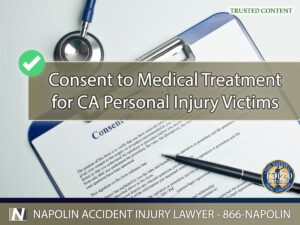A Guide to Consent to Medical Treatment for California Personal Injury Victims
Consent is a fundamental aspect of medical treatment, particularly for personal injury victims in California. Understanding the differences between express and implied consent is crucial in protecting your rights and ensuring that you receive proper medical care. This guide will clarify these concepts, their legal implications, and provide valuable information for those seeking justice after an injury. Ensuring informed consent is not only a legal requirement but also a critical component of ethical medical practice.
Understanding Express Consent
Express consent is a clear, unmistakable agreement given by a patient for a specific medical treatment. In California, express consent is legally required for most medical procedures to ensure that patients are fully informed about the risks and benefits before agreeing to treatment. This type of consent must be explicit, meaning that it is given through verbal or written communication, and it must be obtained without any form of coercion or undue influence.
Legal Requirements for Express Consent in California
In California, express consent must meet specific criteria to be considered valid. The patient must be competent, which means they have the mental capacity to understand the information presented and make an informed decision. Additionally, the patient must be fully informed about the procedure, including its risks, benefits, and alternatives. Finally, the consent must be given voluntarily, without any form of pressure or manipulation. This process ensures that patients have all the necessary information to make an informed choice about their medical treatment.
Detailed Examination of Express Consent Forms
Express consent forms are essential in ensuring that patients understand and agree to the proposed medical treatment. These forms serve as a written record that the patient has been fully informed and has consented to the procedure. They provide a comprehensive overview of the treatment, including potential risks, benefits, and alternatives, ensuring that patients can make an informed decision about their care.
Essential Elements of an Express Consent Form
An express consent form must include several key elements to be legally valid. It should clearly state the patient's name and the date, as well as a detailed description of the procedure to be performed. The form must outline the potential risks and benefits of the procedure, along with any available alternatives. Additionally, it should include a statement confirming that the patient has had the opportunity to ask questions and has received satisfactory answers. Finally, the form must be signed by the patient, indicating their agreement to the treatment.
Common Medical Procedures Requiring Express Consent
Procedures commonly requiring express consent include surgeries, such as appendectomies or heart bypass operations, and complex treatments like chemotherapy and radiation therapy for cancer patients. Other examples include invasive diagnostic tests, such as colonoscopies or endoscopies, and any procedure involving significant risk, such as experimental drug trials. These interventions carry inherent risks, making it essential for patients to provide explicit, informed consent before proceeding.
Exploring Implied Consent
Implied consent is an assumption of permission inferred from a patient's actions, behavior, or circumstances. Unlike express consent, implied consent is not explicitly stated but is assumed based on the patient's conduct or the situation. This type of consent is often used in emergency situations where immediate medical intervention is necessary, and the patient is unable to provide explicit consent.
Definition and Legal Context of Implied Consent
Implied consent is typically inferred in situations where a patient's actions suggest they agree to the treatment. For example, if a patient arrives at an emergency room unconscious, it is assumed they consent to necessary medical treatment to preserve their life or health. In California, implied consent is recognized in specific contexts to facilitate timely and necessary medical care, ensuring that patients receive the treatment they need even when they cannot provide explicit consent.
Common Examples of Implied Consent in Medical Settings
Implied consent often applies in emergency medical situations, such as when a patient is unconscious or incapacitated and requires immediate treatment to prevent serious harm or death. Other examples include routine medical examinations, where the patient's actions, such as presenting themselves for treatment and cooperating with medical staff, imply agreement to the procedure. For instance, if a patient extends their arm for a blood draw, this action is considered implied consent for the procedure.
Limitations and Exceptions to Implied Consent
Implied consent has limitations and is not applicable in all situations. It cannot be assumed for elective procedures or treatments with significant risks that require explicit patient agreement. Additionally, implied consent does not apply if the patient has previously refused the treatment. For example, if a patient has a documented advance directive or has verbally declined a specific treatment, medical professionals must respect these decisions, and implied consent cannot override them.

Legal Implications of Consent in Medical Malpractice
Legal Implications of Consent in Medical Malpractice
The absence of proper consent can lead to medical malpractice claims. If a medical professional fails to obtain valid consent, they may be held liable for any harm resulting from the unauthorized treatment. Understanding the legal implications of consent is essential for both patients and healthcare providers to avoid potential legal issues.
How Lack of Consent Can Lead to Medical Malpractice Claims
When a patient does not provide valid consent, any resulting harm can be grounds for a medical malpractice lawsuit. This includes situations where consent was not obtained or where the patient was not fully informed about the risks and benefits of the procedure. For instance, if a patient suffers complications from surgery they did not agree to, the healthcare provider may be held accountable for performing the procedure without proper consent.
Situations Where Implied Consent Is Insufficient
Implied consent is not adequate for procedures that carry significant risks or are not immediately necessary to preserve life or health. In these cases, express consent must be obtained to avoid legal repercussions. For example, a non-emergency surgery requires explicit patient agreement, and implied consent would not be sufficient to justify performing the procedure. Failure to obtain express consent in such situations can lead to legal claims and potential damages.

Protecting Your Rights Regarding Consent to Medical Treatment in California
Protecting Your Rights Regarding Consent to Medical Treatment in California
Ensuring that your consent is properly documented and understood is vital in protecting your rights as a patient. Taking proactive steps can help prevent misunderstandings and legal issues. Patients should be aware of their rights and responsibilities when it comes to medical consent and seek legal advice if they believe their rights have been violated.
Steps to Ensure Informed Consent Is Properly Documented
Patients should always read and understand consent forms before signing. It is crucial to ask questions about any aspects of the procedure that are unclear and ensure that all risks, benefits, and alternatives are fully explained. Additionally, patients should keep a copy of the signed consent form for their records. This documentation serves as evidence that informed consent was obtained, protecting both the patient and the healthcare provider.
Legal Recourse If Consent Is Not Properly Obtained
If you believe that consent was not properly obtained, you may have legal recourse. Consult with an experienced personal injury lawyer to discuss your case and explore your options for seeking compensation for any harm suffered. Legal professionals can help you understand your rights and navigate the complexities of medical malpractice claims. They can also assist in gathering evidence, negotiating settlements, and representing you in court if necessary.

A Guide to Consent to Medical Treatment for California Personal Injury Victims
A Guide to Consent to Medical Treatment for California Personal Injury Victims
Understanding the nuances of express and implied consent is essential for protecting your rights as a patient. If you or a loved one has been injured and believe that proper consent was not obtained, it is crucial to seek legal assistance. At Napolin Accident Injury Lawyer, we have extensive experience in handling consent-related cases and are dedicated to ensuring that your rights are protected. Contact us today at (866)-NAPOLIN for a free consultation and let us help you secure the justice you deserve. Our team is committed to providing the highest level of legal representation and support, ensuring that your case is handled with the utmost care and expertise.
- A Guide on Red Light Auto Accidents in California - August 14, 2024
- Self-Representing in a California Personal Injury Claim - August 13, 2024
- Common Sources of Distraction for Drivers in California - August 13, 2024
